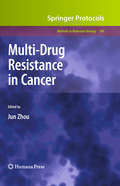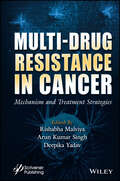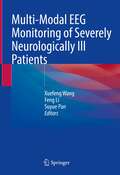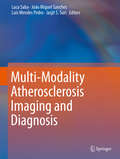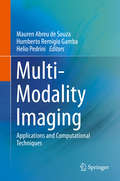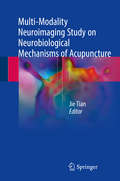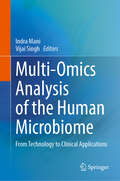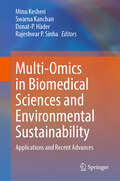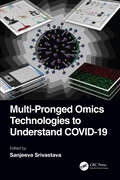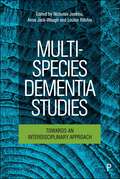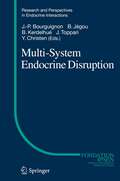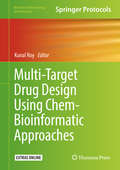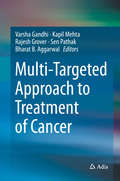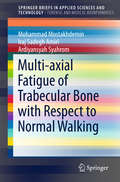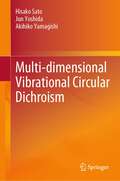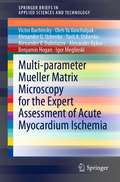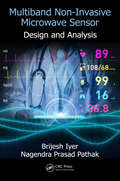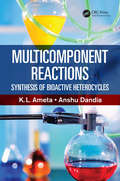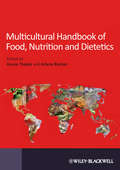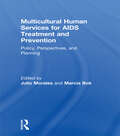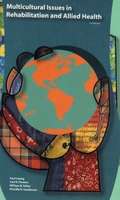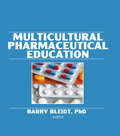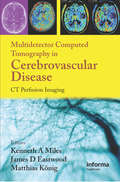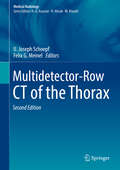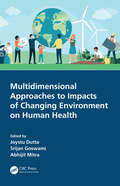- Table View
- List View
Multi-Drug Resistance in Cancer
by Jun ZhouWith the devastating complication of cancer cells becoming simultaneously resistant to many structurally and mechanistically unrelated drugs, the efficacy of chemotherapeutic management of cancer often becomes severely limited. In Multi-Drug Resistance in Cancer, leading researchers in the field provide comprehensive and up-to-date reviews of multidrug resistance mechanisms, from over-expression of ATP-binding cassette drug transporters such as P-glycoprotein, multidrug resistance-associated proteins, and breast cancer resistance protein, to the drug ratio-dependent antagonism and the paradigm of cancer stem cells. The extensive volume also includes strategies to overcome multidrug resistance, from the development of compounds that inhibit drug transporter function to the modulation of transporter expression, as well as techniques for detection and imaging of drug transporters, methods for investigation of drug resistance in animal models, and strategies to evaluate the efficacy of resistance reversal agents. As a volume in the highly successful Methods in Molecular BiologyTM series, this work provides the kind of detailed description and implementation advice that is crucial for getting optimal results. Authoritative and cutting-edge, Multi-Drug Resistance in Cancer offers a state-of-art collection of reviews and methods for both basic and clinician investigators who are interested in the vital study of cancer multi-drug resistance mechanisms and reversal strategies.
Multi-Drug Resistance in Cancer: Mechanism and Treatment Strategies
by Arun Kumar Singh Rishabha Malviya Deepika YadavMULTI-DRUG RESISTANCE IN CANCER The book details the mechanisms underlying multi-drug cellular resistance and the targets of novel chemotherapeutic agents. Cancer is a major killer all over the world. Even with all the progress made, chemotherapy is still the mainstay of modern cancer treatment. The progression of the cellular defeat of numerous independent anticancer drugs in terms of their chemical structure is a major barrier to successful chemotherapy. Multi-drug resistance (MDR) is a term for the fact that most cancer patients exhibit this phenomenon. According to the numbers, drug resistance carries the blame for 90% of cancer patient deaths. Refractory cancer and tumor recurrence are common outcomes of prolonged chemotherapy. Because of the prevalence of drug-resistance mutations, the difficulty of treating tumors increases and the therapeutic efficacy of drugs decreases. Multi-Drug Resistance in Cancer: Mechanism and Treatment Strategies contains nine chapters that cover topics such as: studying the mechanics of resistance to drugs by autophagy; studies to delineate the role of efflux transporters; expression of drug transporters; resistance to targeted therapies in breast cancer; advances in metallodrug driven combination treatment for cancer; and use of natural agents for the overcoming of cancer drug resistance. The book aims to provide the latest data on the mechanisms of cellular resistance to anticancer agents currently used in clinical treatment. It provides a better understanding of the mechanisms of MDR and targets of novel chemotherapy agents which should guide future research concerning new effective strategies in cancer treatment. Audience This book is written for pharmaceutical and biomedical scientists and researchers at both the bench and in the clinic who are interested in the mechanisms and strategies for overcoming cancer’s multi-drug resistance.
Multi-Modal EEG Monitoring of Severely Neurologically Ill Patients
by Feng Li Xuefeng Wang Suyue PanThis book provides practical information on applications of multi-modal EEG monitoring in patients with severely neurologically diseases. The First part systematically introduces the modern EEG techniques, and multi-modal EEG monitoring system for severe neurological illness. In the second part, identification of EEG artifacts and interpretation of common abnormal EEG patterns is presented. Accompanying more than 50 typical cases and 200 EEG records, the following chapters discusses EEG’s changes and clinical significance in coma, ischemic-hypoxic encephalopathy, status epilepsy, Creutzfeldt-Jakob disease, traumatic brain injury, and other diseases in details. In addition, application of multi-modal EEG in monitoring intracranial pressure and predicting suicide risk is also included. It will be a valuable reference for professionals in neurology, neurosurgery, emergency care, psychiatry, technology specialists of EEG and senior nurses with basic EEG monitoring knowledge.
Multi-Modality Atherosclerosis Imaging and Diagnosis
by Jasjit S. Suri João Miguel Sanches Luca Saba Luís Mendes PedroStroke is one of the leading causes of death in the world, resulting mostly from the sudden ruptures of atherosclerosis carotid plaques. Understanding why and how plaque develops and ruptures requires a multi-disciplinary approach such as radiology, biomedical engineering, medical physics, software engineering, hardware engineering, pathological and histological imaging. Multi-Modality Atherosclerosis Imaging, Diagnosis and Treatment presents a new dimension of understanding Atherosclerosis in 2D and 3D. This book presents work on plaque stress analysis in order to provide a general framework of computational modeling with atherosclerosis plaques. New algorithms based on 3D and 4D Ultrasound are presented to assess the atherosclerotic disease as well as very recent advances in plaque multimodality image fusion analysis. The goal of Multi-Modality Atherosclerosis Imaging, Diagnosis and Treatment is to fuse information obtained from different 3D medical image modalities, such as 3D US, CT and MRI, providing the medical doctor with some sort of augmented reality information about the atherosclerotic plaque in order to improve the accuracy of the diagnosis. Analysis of the plaque dynamics along the cardiac cycle is also a valuable indicator for plaque instability assessment and therefore for risk stratification. 4D Ultrasound, a sequence of 3D reconstructions of the region of interest along the time, can be used for this dynamic analysis. Multimodality Image Fusion is a very appealing approach because it puts together the best characteristics of each modality, such as, the high temporal resolution of US and the high spatial resolutions of MRI and CT.
Multi-Modality Imaging: Applications and Computational Techniques
by Mauren Abreu de Souza Humberto Remigio Gamba Helio PedriniThis book presents different approaches on multi-modality imaging with a focus on biomedical applications. Medical imaging can be divided into two categories: functional (related to physiological body measurements) and anatomical (structural) imaging modalities.In particular, this book covers imaging combinations coming from the usual popular modalities (such as the anatomical modalities, e.g. X-ray, CT and MRI), and it also includes some promising and new imaging modalities that are still being developed and improved (such as infrared thermography (IRT) and photoplethysmography imaging (PPGI)), implying potential approaches for innovative biomedical applications.Moreover, this book includes a variety of tools on computer vision, imaging processing, and computer graphics, which led to the generation and visualization of 3D models, making the most recent advances in this area possible. This is an ideal book for students and biomedical engineering researchers covering the biomedical imaging field.
Multi-Modality Neuroimaging Study on Neurobiological Mechanisms of Acupuncture
by Jie TianThis book introduces essential advances in acupuncture studies using multi-modality neuroimaging, which provides insights into how specific brain networks are involved in acupuncture effects in humans. Stimulating different acupoints to treat various clinical conditions is usually accompanied by multi-dimensional physiological as well as psychological responses, which are regulated by the central nervous system. The book addresses disease-specific neural correlates and acupuncture-targeted regulatory encoding in the brain, and explains the temporal-spatial encoding in brain networks to clarify the acupuncture mechanisms. By highlighting the targeting mechanisms of typical indications of acupuncture, this book provides a scientific explanation for acupuncture therapy.
Multi-Omics Analysis of the Human Microbiome: From Technology to Clinical Applications
by Vijai Singh Indra ManiThis book introduces the rapidly evolving field of multi-omics in understanding the human microbiome. The book focuses on the technology used to generate multi-omics data, including advances in next-generation sequencing and other high-throughput methods. It also covers the application of artificial intelligence and machine learning algorithms to the analysis of multi-omics data, providing readers with an overview of the powerful computational tools that are driving innovation in this field. The chapter also explores the various bioinformatics databases and tools available for the analysis of multi-omics data. The book also delves into the application of multi-omics technology to the study of microbial diversity, including metagenomics, metatranscriptomics, and metaproteomics. The book also explores the use of these techniques to identify and characterize microbial communities in different environments, from the gut and oral microbiome to the skin microbiome and beyond. Towards theend, it focuses on the use of multi-omics in the study of microbial consortia, including mycology and the viral microbiome. The book also explores the potential of multi-omics to identify genes of biotechnological importance, providing readers with an understanding of the role that this technology could play in advancing biotech research. Finally, the book concludes with a discussion of the clinical applications of multi-omics technology, including its potential to identify disease biomarkers and develop personalized medicine approaches. Overall, this book provides readers with a comprehensive overview of this exciting field, highlighting the potential for multi-omics to transform our understanding of the microbial world.
Multi-Omics in Biomedical Sciences and Environmental Sustainability: Applications and Recent Advances
by Rajeshwar P. Sinha Donat-P. Häder Minu Kesheri Swarna KanchanThis book offers a comprehensive exploration of the cutting-edge multi-omics technologies that are revolutionizing research across biomedical sciences and environmental sustainability. It addresses the urgent need for interdisciplinary research by integrating multi-omics approaches with bioinformatics and artificial intelligence. The book explores evolution of traditional omics technologies into comprehensive multi-omics strategies that synergize data output through advanced computational tools. It covers diverse topics such as health and disease mechanisms, drug discovery innovations, COVID-19 responses, cancer treatment personalization, neuroscience insights into brain disorders, cyanobacterial natural compounds' potential for biofuel production, lichen symbiosis studies, and more. This volume integrates genomics, proteomics, metabolomics, and more with bioinformatics, machine learning, and artificial intelligence to address complex challenges in health and the environment. With contributions from renowned scholars worldwide, this book illuminates recent advances through illustrative figures and case studies that enhance understanding of complex pathways while bioinformatics strategies streamline research outcomes. This book is a must-read for researchers, academics, and professionals in life sciences, biomedical fields, and environmental studies, interested in advancing their knowledge of multi-omics applications. It is also beneficial for scientists involved in drug design or biotechnological innovations related to environmental sustainability.
Multi-Pronged Omics Technologies to Understand COVID-19
by Sanjeeva Srivastava"COVID-19 and Omics Technologies" is a comprehensive, integrative assessment of recent information and knowledge collected on SARS-CoV-2 and COVID-19 during the pandemic based on omics technologies. It demonstrates how omics technologies could better investigate the infectious disease and propose solutions to the current concerns. The value of multi-omics technologies in understanding disease etiology and host response, discovering infection biomarkers and illness prediction, identifying vaccine candidates, discovering therapeutic targets, and tracing pathogen evolution is discussed in this book. These factors combine to make it a valuable resource to enhance understanding of both "Omics technology" and "COVID-19" as a disease. The book covers the most recent understanding of COVID-19 and the applications of cutting-edge studies, making it accessible to a large multidisciplinary readership. The book explains how high-throughput technologies and systems biology might assist to solve the pandemic’s challenges and deconstruct and appreciate the substantial contributions that omics technologies have made in predicting the path of this unforeseeable pandemic. Features: In-depth summary of clinical presentation, epidemiological impact, and long-term sequelae of COVID-19 pandemic. A systematic overview of omics-based approaches to the study of COVID-19 biology. Recent research results and some pointers to future advancements in methodologies used. Detailed examples from recent studies on COVID-19 encompassing different omics methodologies. A detailed description of methodologies and notes on the applications of state-of-the-art technologies. This book is intended for scientists who need to understand the biology of COVID-19 from the perspective of omics investigations, as well as researchers who want to employ omics-based technologies in disease biology.
Multi-Species Dementia Studies: Towards an Interdisciplinary Approach
by Nicholas Jenkins, Anna Jack-Waugh and Louise RitchieDementia is one of the greatest challenges facing humanity in the 21st century. Responding to the global dementia challenge, however, affects more than humans alone. We live in a multi-species world but often think about dementia in mono-species ways. From the lab to the living room, other beings are “on the scene” and our relations with them affect how we understand, experience, and respond to dementia. Drawing on cutting-edge work across the social and biological sciences, this book offers readers the tools to respond to dementia in multi-species ways. By exploring a range of topics, from pathology to personhood, contributors highlight how thinking about dementia as a more-than-human phenomenon may enable new ways of responding to our global dementia challenge.
Multi-System Endocrine Disruption
by Yves Christen Jean-Pierre Bourguignon Bernard Jégou Bernard Kerdelhué Jorma ToppariEndocrine disruption is an expanding field due to the numerous chemicals involved and, as evidenced more recently, the variety of homeostatic systems that they can alter throughout life. The gathering of experts from all over the world should help to identify health disorders that are possibly or likely related to exposure to endocrine disrupters. The research needs have been discussed as well as recommendations prioritizing target groups and following the precautionary principle.
Multi-Target Drug Design Using Chem-Bioinformatic Approaches (Methods in Pharmacology and Toxicology)
by Kunal Roy<p>This detailed book showcases recent advances in computational design of multi-target drug candidates involving various ligand and structure-based strategies. Different chem-bioinformatic modeling strategies that can be applied for design of multi-target drugs as well as important databases and web servers in connection with multi-target drug design are also featured in this collection. Written for the Methods in Pharmacology and Toxicology series, chapters include the kind of key implementation advice that will aid researchers greatly in their laboratory pursuits. <p>Authoritative and practical, Multi-Target Drug Design Using Chem-Bioinformatic Approaches seeks to aid all scientists working in the field of drug discovery research.</p>
Multi-Targeted Approach to Treatment of Cancer
by Kapil Mehta Bharat B. Aggarwal Varsha Gandhi Rajesh Grover Sen PathakIn this book, clinicians and basic scientists from USA, India, and other countries discuss the rationales and clinical experiences with targeted approaches to treat, prevent, or manage cancer. Cancer is a hyperproliferative disorder that is regulated by multiple genes and multiple cell signaling pathways. Genomics, proteomics, and metabolomics have revealed that dysregulation of dozens of genes and their products occur in any given cell type that ultimately leads to cancer. These discoveries are providing unprecedented opportunities to tackle cancer by multi-faceted approaches that target these underpinnings. This book emphasizes a multi-targeted approach to treating cancer, the focus of the 5th International Conference on Translational Cancer Research that was held in Vigyan Bhawan, Delhi (India) from Feb 6-9, 2014.
Multi-axial Fatigue of Trabecular Bone with Respect to Normal Walking
by Ardiyansyah Syahrom Iraj Sadegh Amiri Mohammad MostakhdeminThis book focuses on the analysis and treatment of osteoporotic bone based on drug administration, tracking fatigue behavior and taking into consideration the mechanical interaction of implants with trabecular bone. Weak trabeculae are one of the most important clinical features that need to be addressed in order to prevent hip joint fractures.
Multi-dimensional Vibrational Circular Dichroism
by Akihiko Yamagishi Hisako Sato Jun YoshidaThis book provides the reader with the latest research on vibrational circular dichroism (VCD) spectroscopy including its useful features and applications to many fields. The book starts from an unresolved question in gel chemistry of how component molecules are organized in the flexible fibrils of gels. VCD spectroscopy was successful in giving a clear answer to this mystery. The book also describes a key aspect of this technique lay in the fact that VCD signals were remarkably enhanced when chiral molecules formed a stereoregular molecular array over a few hundred nanometers. VCD spectroscopy was also applied to other topics involving chiral molecules such as the chiral discrimination mechanism in heterogeneous asymmetric catalysis and the build-up of supramolecular chirality in molecular crystals. Furthermore, the book covers the recent instrument developments leading to multi-dimensional VCD measurements with the coordinates of wavenumber, space and time. This progress has opened up new biological and medical applications such as the heterogenous distributions of protein domains in insect wings and the quality control of chiral drugs. The last part of the book presents the possibility of medical diagnosis of Alzheimer’s disease through multi-dimensional VCD analyses. This book appeals not only to researchers and students who study spectroscopy but also to ones in catalysis, biology and medicine as users of the VCD methods.
Multi-parameter Mueller Matrix Microscopy for the Expert Assessment of Acute Myocardium Ischemia (SpringerBriefs in Applied Sciences and Technology)
by Igor Meglinski Victor Bachinsky Alexander Bykov Benjamin Hogan Oleh Ya Vanchulyak Alexander G. Ushenko Yurii A. Ushenko Alexander V. DubolazovThis book provides an essential overview of the basic principles of imaging modalities, accompanied by examples of their applications in modern clinical and associated pre-clinical studies. The monograph is based on the original results of investigation of the efficiency use of laser light and Mueller-matrix polarimetry approach for assessment of myocardial tissues towards confirmation the cause of death. A morphological analysis of necrotic changes in the myocardial tissue of patients that died due to heart attack, coronary heart disease and acute coronary insufficiency was carried out and the data and histological sections of the myocardium inspected utilizing Mueller-matrix mapping of tissue samples with polarized light. A unified optical model of polycrystalline structure of the myocardium is proposed, and the principles and regulations of Mueller-matrix description of its polarization manifestations are explored and developed. The book also provides a statistical and scale-selective wavelet analysis of polarization and Mueller-matrix maps. Finally, the key forensic medical criteria for the differential diagnosis of the cause of death due to necrotic and pathological changes in the morphological structure of the myocardium have been established
Multiband Non-Invasive Microwave Sensor: Design and Analysis
by Brijesh Iyer Nagendra Prasad PathakThis monograph focuses on the design, implementation and characterization of a concurrent dual band RF sensor for non-invasive detection of human vital signs. Exclusive title on multiband short range sensors and their biomedical applications, offers detailed analysis of subsystems based on fabricated and measured prototypes and verifies and discusses the system in the real-time environment. <P><P> Discusses the practical difficulties of the design process and offers case studies based on the design.
Multicomponent Reactions: Synthesis of Bioactive Heterocycles
by K. L. Ameta Anshu DandiaThis timely book provides a succinct summary of methods for the synthesis of bioactive heterocycles using a multicomponent reaction (MCR) approach. The majority of pharmaceuticals and biologically active agrochemicals are heterocycles while countless additives and modifiers used in industrial applications are heterocyclic in nature. With the recent introduction of high-throughput biological evaluation, the importance of MCRs for drug discovery has been recognized and considerable efforts have been focused especially on the design and development of multi-component procedures for the generation of various bioactive heterocycles due to their significant therapeutic potential.
Multicultural Handbook of Food, Nutrition and Dietetics
by Arlene Barton Aruna ThakerMulticultural Handbook of Food, Nutrition and Dietetics is the must have practical resource for dietitians, nutritionists and students working with both well settled but also recently migrated ethnic groups.<P><P>Written by a team of authors drawn from the British Dietetic Association's Specialist Multicultural Nutrition Group the book provides in-depth information to equip the reader in the provision of nutrition advice to minority groups. Spanning a broad range of cultural groups the book seeks to consider religious and cultural requirements in relation to traditional diets; research on migration studies and chronic disease states; and nutrition and dietetic treatment in relation to key chronic diseases.
Multicultural Human Services for AIDS Treatment and Prevention: Policy, Perspectives, and Planning
by Marcia Bok Julio MoralesThis much-needed book presents an introduction and overview of multicultural AIDS issues in social work practice. In a culturally diverse nation, it is essential that professionals look at AIDS within a cultural context in order to find the most effective treatment and prevention strategies for everyone. Emphasizing this need for a culturally sensitive approach, Multicultural Human Services for AIDS Treatment and Prevention increases social workers’often limited knowledge and experience with various social and ethnic groups. It provides specific suggestions and recommendations for program development and acts as a foundation upon which to build new strategies for policy, research, and practice. Multicultural Human Services for AIDS Treatment and Prevention emphasizes the importance of encouraging and sharing research that addresses AIDS and minority populations and assessing prevention, education, and behavioral change strategies from culturally specific and relevant perspectives. It includes chapters focusing on African Americans, Native American Indians, Hawaiians, Puerto Ricans, and Mexican prostitutes--groups that often suffer disproportionately from poverty and its myriad effects. Some topics discussed in the book are: helping clients reduce cultural dissonance how to enhance behavior change child welfare and permanency planning empowerment of clients and health care models knowledge, attitudes, and behaviors regarding HIV/AIDS cultural contradictions and ambivalence in response to AIDSMulticultural Human Services for AIDS Treatment and Prevention is an extremely useful and informative book for all professionals in social work and human services who want to be better prepared to help all groups of people. The book is also an ideal text for upper-level social work students studying topics such as multicultural issues in social work practice, AIDS in a cultural context, and health policy and health care systems.
Multicultural Issues In Rehabilitation And Allied Health
by Paul Leung Carl R. Flowers William B. Talley Priscilla R. SandersonThis book addresses the multicultural issues as they impact the fields of rehabilitation and allied health.
Multicultural Pharmaceutical Education
by Barry BleidtMulticultural Pharmaceutical Education spotlights methods and theory on how to increase representation of minorities in pharmacy schools and practice settings. Many of the ideas presented in this book are unique, and all provide an opportunity for institutions with few minority students to greatly improve their recruitment and retention efforts geared toward these students. The contributing authors, representing all levels of academia--deans, undergraduate students, vice provosts, executive directors, a National Professor of the Year, and faculty members--have all had experience in some aspect of minority pharmaceutical education. It is through their practical experiences that they offer suggestions and commentary on pharmacy programs of study. Historical accounts or examples of success that could be emulated at other institutions are included. With the help of Multicultural Pharmaceutical Education, colleges and universities and their faculty can forge ahead in attracting and retaining minority students to their pharmacy programs and into the world of pharmacy practice. Structured around four major areas (foundation, commitment, actuation, and conclusion), the authors remove the option of traditional excuses of failure in this important area of education. All those involved in pharmacy education should read this book whether deans, admissions counselors, professors, or students. Multicultural Pharmaceutical Education provides an easy-to-read, practical and theoretical approach to improving the opportunity and quality of education that minority students can achieve in pharmaceutical programs.
Multidetector Computed Tomography in Cerebrovascular Disease: CT Perfusion Imaging
by Matthias König Kenneth A Miles James D EastwoodMultidetector Computed Tomography in Cerebrovascular Disease: CT Perfusion Imaging focuses on anatomy and procedural strategy for perfusion CT imaging in clinical neurology and cerebrovascular disease. This text-atlas combines pictures and schematic diagrams to show how this new modality can be used to assess anatomy and guide therapeutic intervent
Multidetector-Row CT of the Thorax
by U. Joseph Schoepf Felix G. MeinelSince the first edition of this book was published in 2004, computed tomography has seen groundbreaking technical innovations that have transformed the field of thoracic imaging and opened novel possibilities for the detection of thoracic pathologies. This book highlights cutting-edge thoracic applications of CT imaging in the context of these technical innovations and discusses the latest opportunities, with critical appraisal of challenges and controversies. All topics are covered by renowned international experts. Chapters from the original edition have been thoroughly updated to reflect the state of the art in technology and scientific evidence, and new contributions included on recent developments such as dual-energy CT and CT imaging in patients with acute chest pain. The book is abundantly illustrated with high-quality images and illustrations.
Multidimensional Approaches to Impacts of Changing Environment on Human Health
by Joystu DuttaThe book discusses the indispensable connection between the environment and health via all possible aspects, focussing on human interactions with the environment. The multi-dimensional field of environmental and human health perspectives with emerging issues and current trends is illustrated through supporting case studies, reviews, research reports and examples. It also covers crucial areas of research such as vector control in a tropical climate, influence of climate change on human health and so forth, including proliferation of microbial diseases. Environmental, health and safety guidelines are discussed as well. Aimed at graduate students and researchers in environmental and medical sciences, health and safety, and ecology, this book Highlights interdisciplinary aspects of environmental changes and associated health risks Explains different aspects of environmental pollution and health risks Includes dedicated chapters on global epidemics and biomedical and municipal waste Contains case studies pertaining to different health and safety issues.
